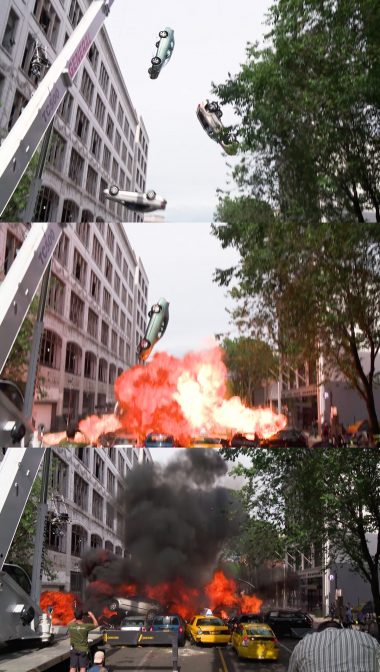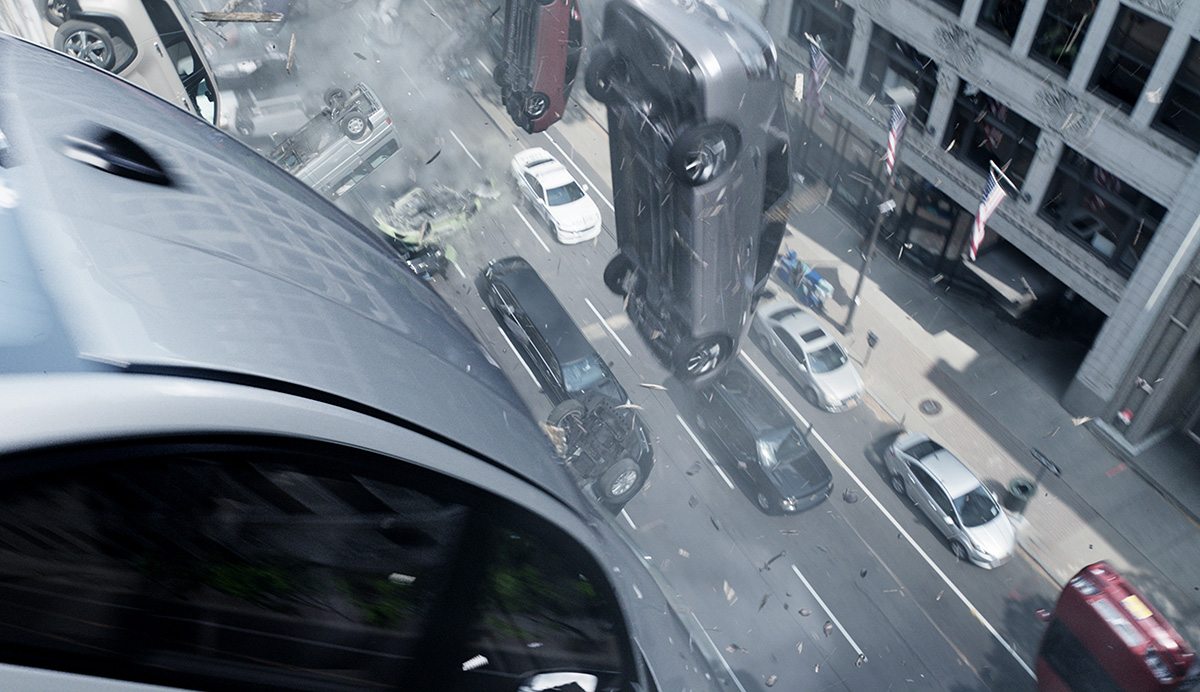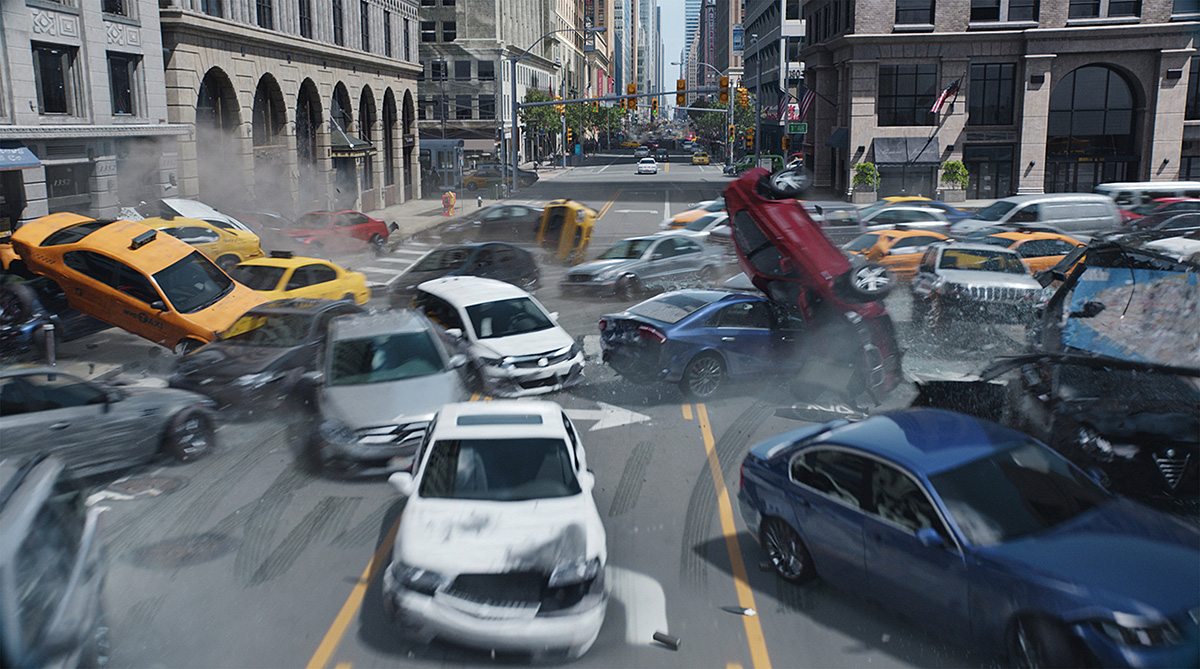The Fast and the Furious franchise has always showcased incredibly audacious practical stunts and effects. But, even since the first film in 2001, digital visual effects have also been an important part of realizing the crazy car chases and other stunts.
The latest installment, The Fate of the Furious, directed by F. Gary Gray, features an elaborate New York autonomous vehicle chase sequence that continues this trend, combining carefully choreographed special effects with matching computer animation.
Cartoon Brew finds out how it was done with visual effects supervisor Alex Wang, who oversaw the digital work at Double Negative for the 'zombie cars' scenes. Members of the studio's animation team also weigh in on the unique approach to animating the cars.
Zombie cars, really?
The set-up for this sequence is simple: the film's villain, Cipher (Charlize Theron), attempts to infiltrate and attack an important motorcade driving through New York city by remotely taking control over other cars in the streets. The ensuing chaos involving hordes of cars is further enhanced by vehicles that launch themselves out of a multi-story car park onto the road below.
Under the supervision of picture car coordinator Dennis McCarthy, second unit director Spiro Razatos, and stunt designers Jack and Andy Gill, a number of practical approaches to the zombie cars sequence were devised. For example, real cars were dropped from the multi-story car park via specialized rigging, falling onto a pile-up of vehicles below.
 This selection of screengrabs from production b-roll shows real cars being dropped from cranes.
This selection of screengrabs from production b-roll shows real cars being dropped from cranes. Real cars were also of course part of the driving scenes, and many were smashed, crashed, and crushed by the stunt team. Then it was time for visual effects to step in (the film's overall vfx supervisors were Michael Wassel and Kelvin McIlwain). Double Negative took advantage of the cars being on set in New York and Cleveland – which partly stood in for New York – and had them scanned and photographed for textures for the studio's matching cg models. Ultimately, the vfx studio would need to build a fleet of around 50 different vehicles. These would be made up of the scanned cars from set as well as an existing library of digital cars Double Negative already had from previous projects.
Digital cars were only half the challenge, however. Since the main stunts were filmed in Cleveland, Double Negative also had to augment the plate photography and generate shots to look like New York. For that, special Roundshot cameras filming on flat bed trucks in New York captured 360 degree environments that could then be used to piece together new backgrounds and for set extension work.
"Cleveland has about ten percent of the architecture that could work for New York, but with a film like this it really needed to feel like New York City," noted Wang. "So the extensions had to be very detailed. And we needed elevated shots to look like helicopter shots, so we also shot 360 degree environments from rooftops in New York."
Animating a car is harder than you think
A common misconception in animating cars is that it is a relatively easy visual effects assignment; placing what is essentially a box on four wheels on a flat surface might seem simple but there are many nuances of movement and suspension. Add to this extra speed, many more cars than normal, and constant crashing – and the assignment is now incredibly challenging.
"The cars would kind of knock with each other a little bit and then they would either hit the curb and hop up on the curb, stuff like that," said Wang. "Suspension work was always definitely something that we always had to nail. Our car rig allowed us to have lots of suspension control and body roll, and we had great animators that would have a lot of reference of, for example Letty's (Michelle Rodriguez) Corvette, being a more classic car, and it would have different suspension than say the Bentley that Roman (Tyrese Gibson) was driving."
 A view from the car park.
A view from the car park. Keyframing so many cars was always going to be a major challenge in the zombie sequence. What Double Negative needed was a quick way to manipulate many cars but with the flexibility of allowing adjustment. "All of these requirements saw the entire animation team learning how to do rigid body simulations," said Double Negative animation lead Ben Goerlach.
This side of visual effects is usually left to the 'FX' department, but here the animators used effects simulation tools to art direct shots and provide fast turnarounds. The animation drove the destruction of the body panels for FX, which meant, explains Goerlach, "we had to allow our simulation proxy cars to intersect with one another."
"This consideration meant we could retain almost all of our animation right through to the end of the collisions and avoid FX having to take over and sim the entire vehicle from the point of collision. Instead their sims ran on top of our entire performance ensuring minimal deviation from client approved animation," said Goerlach.
 The horde of animated cars.
The horde of animated cars. This relatively unique animation approach for animation simulations and crash choreography was enabled via Double Negative's adaption and development of Maya 2016's Bullet simulation plugin. "Through close collaboration with Double Negative's Pipe team we were able to create a tool robust and reliable enough to serve as the pivotal addition to our workflow," explained animation lead Justin Henton. "It allowed us the creative freedom and efficiency to deliver some great fun and complex animation."
One particularly over-the-top shot has the horde of cars drifting around a corner and almost piling up on the bend, before continuing. "That is almost an all-cg shot," said Wang. "We had a plate, but that's a perfect example where they pretty much shot that take, but there were not enough cars. There wasn't enough energy in the cars, so we definitely took over that shot with a cg shot so we could give what the director wanted."
"And because it was shot in Cleveland we had to do pretty much a huge overhaul on the environment work as well," added Wang. "The plate is a motorcade driving down the street and everything else is cg. The animator had no choice but to really rely on Bullet to get a first-pass simulation of what that amount of cars would look like and then go in there and art direct things a little bit more, and add more weight, add more suspension to everything."
Blurring the line between real and fake
After working on the zombie car sequence for a while, in which practical cars and cg cars shared the frame, even Wang's team at Double Negative started confusing which cars were which. So did their clients.
"We were showing a shot to the director and for a long time they thought that a car in the foreground was a practical, real car," said Wang. "And we had to tell them that it was a cg car. I mean there's no better compliment than something like that for us."




